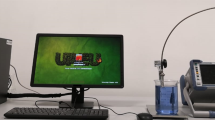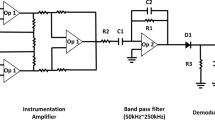Abstract
A Van der Pauw electrolytic conductivimeter was development to calibrate an electrical resistivity probe. This conductivimeter is used in studies of early cancer screening because such studies require a measurement probe, i.e., tetra-polar probe, which needs to be calibrated. The standard calibration procedure uses electrolytic solutions of known electrical conductivities. The development Van der Pauw electrolytic conductivimeter should be used as primary standard in the probe calibration. A maximum measurements uncertainty of 1.64% was achieved.
Access this chapter
Tax calculation will be finalised at checkout
Purchases are for personal use only
Preview
Unable to display preview. Download preview PDF.
Similar content being viewed by others
Referencias
Measurement, Instrumentation, and Sensors Handbook (1999) CRCnetBase. cap 43.
Van Der Pauw L.J. (1958) A Method Of Measuring The Resistivity And Hall Coefficient On Lamellae Of Arbitrary Shape. Philips Technical Review. Vol 20; p. 220–224.
Moron Z, Rucki Z, Szczepanik Z. et al. (1997) Possibilities of employing a calculable four-electrode conductance cell to substitute the secondary standards of electrolytic conductivity. IEEE: Transactions on Instrumentation and Measurement. Vol. 46, No 3; p. 1269.
Moron Z, et al. (2003) Investigations of van der Pauw method applied for measuring electrical conductivity of electrolyte solutions, Measurement of electrolytic conductivity. Elsevier Science Ltd. Measurement 33; p. 281–290.
Szczepanik Z, Rucki Z, Moron Z, et al. (1996) Application of finite element Analysis Method for Modeling of Electric Field Distribution in Conductance Cells. Institute of Electrical Metrology, Technology Conference, Brussels, Belgium 127–131.
Fishbane P, Gasiorowicz S, Thornton S (1994) Física para Ciencias e Ingeniería. Prentice may, México.
Denaro A (1965) Elementary Electrochemistry. Butterworths.
Edminister J. (1998) Electromagnetismo. McGraw Hill, México.
Measurement, Instrumentation, and Sensors Handbook (1999) CRCnetBase cap 70.
Practical Considerations for Conductivity and Total Dissolved Solids Measurement, OAKTON Tech Tips, Tech Tip #8, 1997.
Grimnes S, Martinsen O. Bioimpedance and Biolectricity: Basics. Great Britain: Academic Press, 2000. ISBN:0123032601.
Author information
Authors and Affiliations
Editor information
Editors and Affiliations
Rights and permissions
Copyright information
© 2007 Springer-Verlag Berlin Heidelberg
About this paper
Cite this paper
Jaimes Morales, S.A., Valencia Quintero, J.P., Miranda Mercado, D.A. (2007). Diseño de un medidor de conductividad electrolítica, para operar en el rango de conductividad eléctrica del tejido humano. In: Müller-Karger, C., Wong, S., La Cruz, A. (eds) IV Latin American Congress on Biomedical Engineering 2007, Bioengineering Solutions for Latin America Health. IFMBE Proceedings, vol 18. Springer, Berlin, Heidelberg. https://doi.org/10.1007/978-3-540-74471-9_106
Download citation
DOI: https://doi.org/10.1007/978-3-540-74471-9_106
Publisher Name: Springer, Berlin, Heidelberg
Print ISBN: 978-3-540-74470-2
Online ISBN: 978-3-540-74471-9
eBook Packages: EngineeringEngineering (R0)




